False Machine (2)
By:
June 17, 2015
The following post originally appeared at Patrick Stuart’s blog False Machine. It is one in a series of 10 analyzing the mini (miniature figure, used in wargames) and other small-scale fantasy and sci-fi models as an art form.
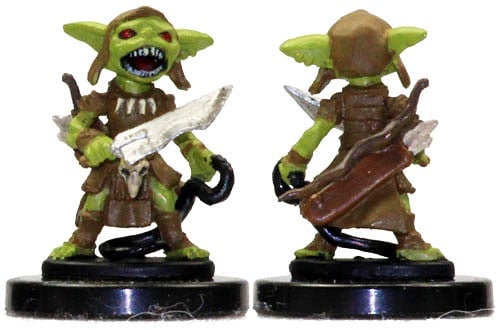
What a surprise is Herbert Read’s 1951 book The Art of Sculpture. I picked it out at the library because it was large and official-looking, and featured lots of pictures. By pure chance, it was absolutely what I needed, at this stage in my thinking about minis as art-forms.
Through the history of sculpture, according to Read, the ‘Painterly’ and the ‘Plastic’ are in conflict. “Painterly” sculpture is made to do what painting does — i.e., create a striking image — but with different materials. Read prefers “plastic” sculpture, which is made to occupy space in a particular way, made to contain weight and depth — and to project spatial presence.
Giovanni Lorenzo Bernini’s Ecstasy of St Theresa is painterly.
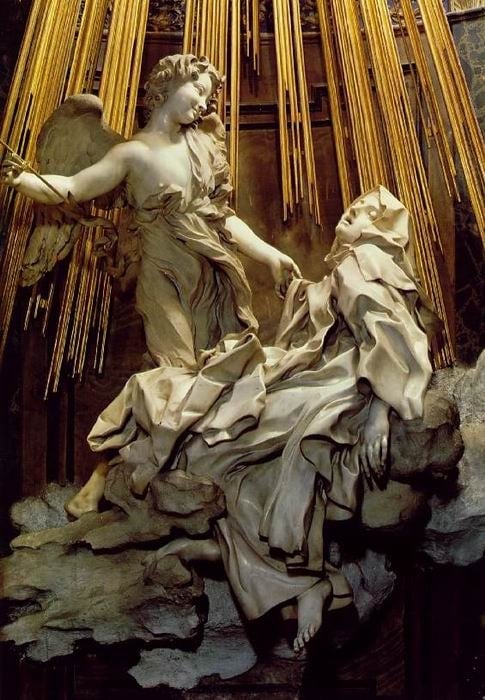
Tino di Camaino’s La Carità is plastic.
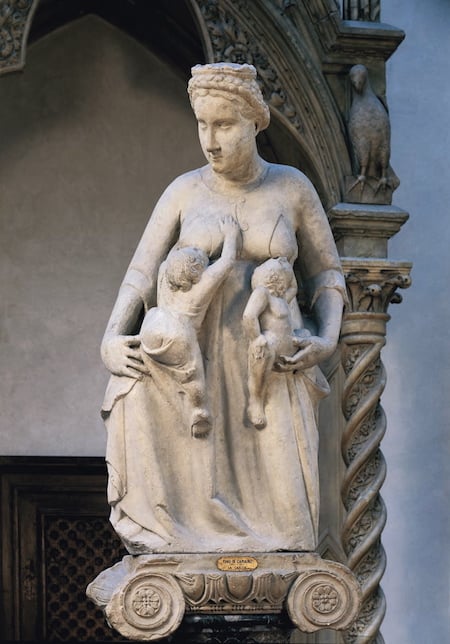
All of which makes me think of elves and dwarves — as portrayed, that is, by the creators of miniatures.
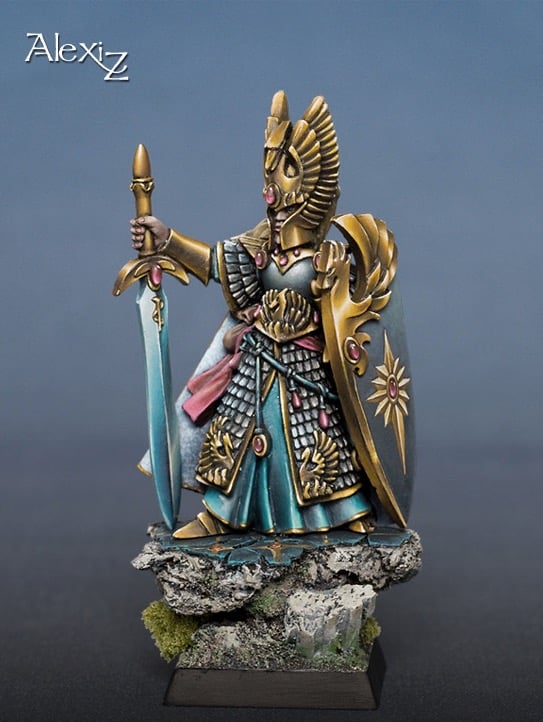
Elf minis tend to be “painterly,” in Read’s definition of the term. They are kind of an illusion. The material is not being itself — it is being transformed, with skill, to create the pretence of another kind of matter. To float. This can be very impressive, but Read laments that “painterly” works, which prioritize the image over the physical mass, separate sculpture from its core. Sculptures can do something that images cannot.
Inserting himself into the mind of a “plastic” sculptor like Rodin, Read has a number of fascinating things to say. According to Read, Rodin understood that the human mind tends to play over surfaces, rather than familiarize itself with depths — i.e., it’s easier to be a painterly artist than a plastic artist.
“Henceforth, when you carve, never see the form in length, but always in thickness,” Read quotes one of Rodin’s advisors “Never consider a surface except as the extremity of a volume, as the point, more or less large, which it directs toward you. In that way you will acquire the science of modelling.”
“Michelangelo, whose work had this [‘plastic’] compactness,” Read also notes, “said that only those works were good that could be rolled from the top to the bottom of the mountain without breaking.”
Which brings us to dwarves.

Dwarf minis embody mass. They occupy space. You could roll them downhill and nothing would snap off. If they are interesting to look at, it is probably a secondary effect of the way they occupy space.
Now we have a problem here in that we can only look at these pictures of miniatures; we can’t feel them. When I look at these images, I pretend that the miniatures are life-size, and imagine pressing my hands and entire body against them. It’s possible that I am being a little mad, but Read had the same idea: “It is very difficult to convey the nature of the sensations by descriptive words or even by photographic illustrations. Ideally each reader of this volume should be provided, at this stage, with a piece of sculpture to hug, cuddle, fondle — primitive verbs that indicate a desire to treat an object with plastic sensibility.” Dwarf minis are more cuddly than elf minis.
I like Read’s idea of getting to know sculpture by stroking or cuddling it, but the tiny size of minis makes that more or less impossible. However, when we paint minis we feel them virtually — through the tip of a paintbrush, whose movements we’re studying with intense concentration. I’ve always loved painting goblin minis, more than any other kind of mini.
If the elf mini is “painterly” (more about the visual than the tactile), and the dwarf mini is “plastic” (more about the tactile than the visual), then the goblin mini is haptic — it’s not about the visual at all.
Are you familiar with the haptic homunculus? It’s a pictorial representation of the human body, where those parts of the body with denser nerve endings are depicted proportionally larger than less sensitive parts. Congenitally blind children often sculpt the body with these proportions.
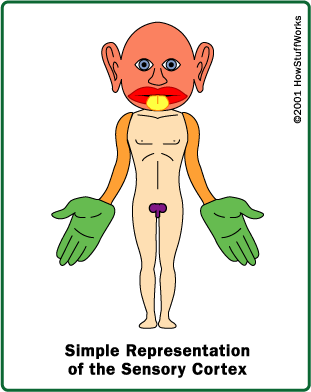
Goblin features and body parts are all out of proportion. They’re haptic homunculi.
Early Citadel lead miniatures [Citadel produced minis in the late ’70s and early ’80s, before being absorbed by Games Workshop] were less perfect, in some ways, than today’s miniatures. By which I mean they were less “painterly” — more crude, less perfect as pictured things. But they occupied space and held mass in an impressively “plastic” way, which suggests that they were more purely sculptural than today’s minis.
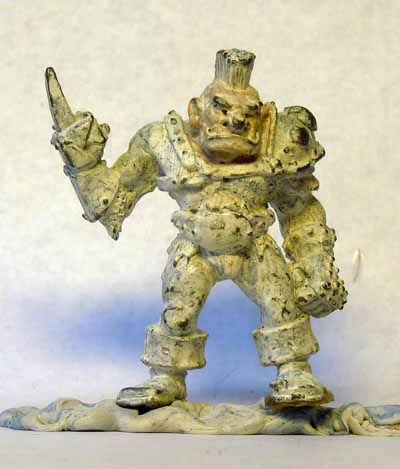
Plus, Citadel minis were made of lead: they were heavier than today’s minis. The miniature is a tactile, haptic art-form.
The handling of carved objects, according to Read, played a key role in the development of sculpture away from a purely decorative function towards an art form: “Again, as in Greece and Egypt, it was only in and through Kleinplastik, small objects that can actually be handled, that sculpture became emancipated from all architectonic and utilitarian purposes and conceived as an independent plastic art.”
This gets at what I find so intriguing about minis. They’re not meant to be simply looked at, like a painting, but handled.
CURATED SERIES at HILOBROW: UNBORED CANON by Josh Glenn | CARPE PHALLUM by Patrick Cates | MS. K by Heather Kasunick | HERE BE MONSTERS by Mister Reusch | DOWNTOWNE by Bradley Peterson | #FX by Michael Lewy | PINNED PANELS by Zack Smith | TANK UP by Tony Leone | OUTBOUND TO MONTEVIDEO by Mimi Lipson | TAKING LIBERTIES by Douglas Wolk | STERANKOISMS by Douglas Wolk | MARVEL vs. MUSEUM by Douglas Wolk | NEVER BEGIN TO SING by Damon Krukowski | WTC WTF by Douglas Wolk | COOLING OFF THE COMMOTION by Chenjerai Kumanyika | THAT’S GREAT MARVEL by Douglas Wolk | LAWS OF THE UNIVERSE by Chris Spurgeon | IMAGINARY FRIENDS by Alexandra Molotkow | UNFLOWN by Jacob Covey | ADEQUATED by Franklin Bruno | QUALITY JOE by Joe Alterio | CHICKEN LIT by Lisa Jane Persky | PINAKOTHEK by Luc Sante | ALL MY STARS by Joanne McNeil | BIGFOOT ISLAND by Michael Lewy | NOT OF THIS EARTH by Michael Lewy | ANIMAL MAGNETISM by Colin Dickey | KEEPERS by Steph Burt | AMERICA OBSCURA by Andrew Hultkrans | HEATHCLIFF, FOR WHY? by Brandi Brown | DAILY DRUMPF by Rick Pinchera | BEDROOM AIRPORT by “Parson Edwards” | INTO THE VOID by Charlie Jane Anders | WE REABSORB & ENLIVEN by Matthew Battles | BRAINIAC by Joshua Glenn | COMICALLY VINTAGE by Comically Vintage | BLDGBLOG by Geoff Manaugh | WINDS OF MAGIC by James Parker | MUSEUM OF FEMORIBILIA by Lynn Peril | ROBOTS + MONSTERS by Joe Alterio | MONSTOBER by Rick Pinchera | POP WITH A SHOTGUN by Devin McKinney | FEEDBACK by Joshua Glenn | 4CP FTW by John Hilgart | ANNOTATED GIF by Kerry Callen | FANCHILD by Adam McGovern | BOOKFUTURISM by James Bridle | NOMADBROW by Erik Davis | SCREEN TIME by Jacob Mikanowski | FALSE MACHINE by Patrick Stuart | 12 DAYS OF SIGNIFICANCE | 12 MORE DAYS OF SIGNIFICANCE | 12 DAYS OF SIGNIFICANCE (AGAIN) | ANOTHER 12 DAYS OF SIGNIFICANCE | UNBORED MANIFESTO by Joshua Glenn and Elizabeth Foy Larsen | H IS FOR HOBO by Joshua Glenn | 4CP FRIDAY by guest curators
